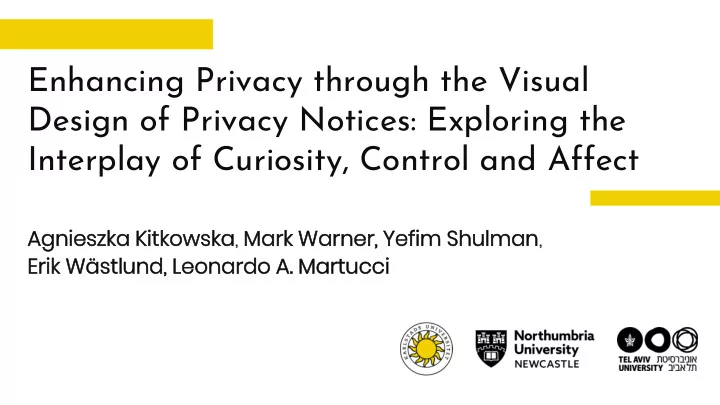

Enhancing Privacy through the Visual Design of Privacy Notices: Exploring the Interplay of Curiosity, Control and Affect Agnies ieszka zka Kitkow kowska ka, Mark k Warner, r, Yefim m Shul ulman man, Erik k Wästlund, und, Leonard nardo o A. Martuc ucci
Problem Privacy Notice ▪ Must be acknowledged ▪ Provide no choice ▪ Difficult to understand ▪ Lengthy People & Decisions ▪ Behavioral outcomes influenced by many factors (e.g., individual characteristics, privacy concerns, beliefs; external factors – exposure to stimuli) 2
Research questions About visual design (framing and control) and its influence on: a) Affective state (positive vs negative) b) Privacy comprehension c) Intention to disclose information About psychological factors: a) Curiosity and its effect on comprehension b) Affective state and its role in the attitude-behavior relationship 3
Method ▪ Online experiment with 620 participants Positive framing, no control ▪ Between-subject design ▪ Independent variables: ▪ Manipulated: framing, control; Curiosity. ▪ Dependent variables: ▪ Affect (valence), disclosure, comprehension ▪ Covariates ▪ Concerns, trust, time spent on the policy page Negative framing, control ▪ Statistical analysis Univariate analysis of covariance ▪ (comprehension) Multivariate analysis of covariance ▪ (disclosure and valence) Mediation & moderated mediation (the role ▪ of affect on the relationship between trust, concerns and disclosure) 4
Results: visual design Control Valence significantly differed between control groups, ▪ F(1, 608)=5.8, p=.01, η p 2 <.01 Interaction effect: valence higher among participants provided ▪ control and scoring higher in curiosity, F(1, 608)=7.2, p<.01, η p 2 <.01 Ability to change settings increases comprehension , ▪ F(1, 306)=11.1, p<.01, η p 2 =.02 Ability to change settings influences intention to disclose , ▪ F(1, 306)=12.7, p<.01, η p 2 =.04 ▪ Framing did not affect participants ▪ Time is important! (largest effect size) 5
Results: psychological factors ▪ Curiosity has a significant influence on privacy comprehension, F(1, 608)=8.5, p<0.01, η p 2 =.01 ▪ Significant role of covariates : privacy concerns, trust implying that stable factors are better predictors of behavioral outcomes Moderated-mediation: ▪ Privacy concerns mediate the relationship between trust and information disclosure, b=.97, t(618)=8.06, p<0.01, CI[.06, .20] ▪ Valence moderates the relationship between trust and concerns (scores on valence lower than 2.71 result in more negative relationship between trust and concerns) 6
Summary We learned that: ▪ Affording control perceived positively – potential for usability ▪ Valence moderates attitudes – affecting disclosure ▪ Privacy UIs: enhance curiosity and extend engagement time to improve comprehension Limitations & Future work ▪ Effect sizes ▪ Use methods different than self-reports to measure affect (e.g., EEG) ▪ Test different contexts 7
“Enhancing Privacy through the Visual Design of Privacy Notices: Exploring the Interplay of Curiosity, Control and Affect” Agnieszka Kitkowska , Mark Warner, Yefim Shulman, Erik Wästlund, Leonardo A. Martucci agnieszka.kitkowska@kau.se www.akitkowska.com @agakitkowska Thank you This project has received funding from the European Union’s Horizon 2020 research and innovation programme under the Marie Skłodowska -Curie grant agreement No 675730
Recommend
More recommend